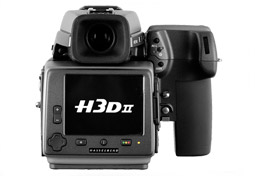Comparing the H3DII 50 to the new Phase One P65+ back (with its 60.5 Mpix sensor) is problematic for Hasselblad, however, in that the P65+ takes the lead in every aspect, per the table following:
| Camera Model |
Sensor Size |
Color Depth |
Dynamic Range |
Low-Light ISO |
|
Hasselblad H3DII |
51.7 Mpix |
24.7 |
12.7 |
574 |
|
Phase One P65+ |
60.5 Mpix |
26.0 |
13.0 |
1158 |
Key sensor characteristics
The Hasselblad H3DII-50 sensor features a very high resolution medium-format CCD with 51.7 Mpix manufactured by Kodak; a 16-bit Analog/Digital (A/D) converter; and an ISO range of 50 to 400.
Key performance factors
With respect to ISO sensitivity, the only real ISO provided is ISO 50 (measured sensitivity is 45). All other ISO values are obtained by applying a digital gain during the RAW-to-JPEG conversion, which is the same type of design as for the H3DII 39.
Overall, the Hasselblad H3DII-50’s RAW image quality performance is pretty good. But the launch of the Phase One P65+ has clearly revived competition. But given their respective launch dates (2007-11-26 for the H3DII 50 and 2008-07-14 for the P65+), comparing these two models is arguably a bit unfair to Hasselblad
Disclaimer: This dxomark review evaluates only the selected camera’s RAW sensor performance metrics (i.e., Color Depth, Dynamic Range, and Low-Light ISO), and should not be construed as a review of the camera’s overall performance, as it does not address such other important criteria as image signal processing, mechanical robustness, ease of use, flexibility, optics, value for money, etc. While RAW sensor performance is critically important, it is not the only factor that should be taken into consideration when choosing a digital camera.





DXOMARK encourages its readers to share comments on the articles. To read or post comments, Disqus cookies are required. Change your Cookies Preferences and read more about our Comment Policy.